Popular Topics
Trip Report
Santiago de Compostela, Finisterre and Vigo with backpack on the shoulder
Like real pilgrims, my friend Emma and I walked from Santiago de Compostela to Finisterre. Then we go to Vigo for family holidays.
EuropeSpain8 days / July - August 2020
Highs & Lows
The landscapes are completely different when you walk.
Because of the COVID is difficult to find hostels and normal activities.
Itinerary Overview
Galicia, in the north of Spain, is one of the most diverse provinces in terms of landscapes and gastronomy. Due to the Camino de Santiago you can reach this region on foot. Everything is possible calmly and with friends everything is more fun. The technology is very useful to find routes and enabled sites in time of COVID. Get ready for 85 kilometers of adventure.

Santiago de Compostela Spirituality, architecture and food in Santiago de Compostela

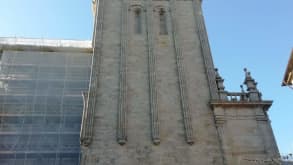
 4+
4+Day 1
All this adventure started in Santiago de Compostela. It was the last days of July and I had come walking to Santiago from Madrid (on one of the routes of the Camino de Santiago, but that is another story). Like all the pilgrims, I wanted to visit the famous city’s Cathedral, where is the tomb of the apostle Santiago. Unfortunately, the place is under repair inside and out, and it was impossible for me to see the architecture fully. However, I was able to be part of a small tour and get to know the place where the Apostol Santiago’s remains are and where people leave the things, they want to get rid of after walking for many kilometers. I am not religious person, but I can assure you, the Camino de Santiago, has a spiritual power that transforms anyone who decides to do it. I had only one day to be alone in Santiago before meeting my friend Emma and starting our trip together to Finisterre, so I took my time to lose myself among the narrow streets. In the center of the city there is the Plaza del Obradoiro where the tourist can find live music and rides aboard a small tourist train. I could taste empanada gallega with tuna on the terrace of the Hostal Reyes Católicos. It was delicious. Other places that I visited were the Lake Park and the City of Arts. The view of Santiago de Compostela is really beautiful in this last place. I have to say that the best experience was sleeping in the Albergue Seminario Menor. Why? Because the rooms are individual cells and you really feel that you are in a spiritual trip.

Albergue Alto da Pena Three pilgrims at the first stop, sharing the table
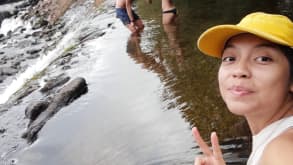

 1+
1+Day 2
Once I was with Emma, we started walking. In addition of the two of us, a surprise guest joined the road that day: Tino, Emma’s cousin. The route from Santiago de Compostela to Finisterre is incredibly famous, so, as in the other routes, there are yellow arrows guiding walkers. Despite this, we downloaded an app in our cellphones that has the indications from Camino to Finisterre. The name of this app is Camino Tool. Honestly, those months were difficult to travel because many shelters were closed because of the COVID pandemic. However, we are people who take the best of each situation and the most important thing for us was to enjoy the journey. The landscape is different when you go in your own speed. Together we crossed roads and forests, before reaching the Ponte Maceira where we could take a break and get into Tambre’s river. For that day we decided to walk only 26 kilometers. Our final destination was Alto da Pena, where we found an open shelter. The shelter has the same name that the location and is a familiar place. We arrived before sunset. At this time of the year, wind was strong and the best thing that we could do was being part in a community dinner, next to the chimney. The cook repeated constantly one of the most popular saying of the region: “Comer hay que comer”. Emma and Tino are galicians and they know very well the meaning of that phrase, but it was the first time that I heard it. It is difficult to translate, but it’s something like eating is necessary, no matter how much you have already eaten. That night, we share the table and had a conversation with people of different nations: Spanish, Italian and Russian.

Olveiroa Way to the sea. The Xallas river is a great place to to recharge before walking again.
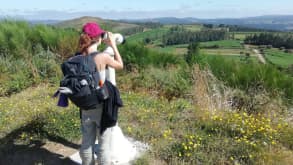
Day 3
The third day started early in the morning. Emma and I carry our backpacks and leave Tino behind, because he only could walk with us one day. Our destination was Olveiroa, a small village next to the Xallas river. To get there, we crossed the rural areas of La Coruña such as Maroñas, Santa Marina and A Gueima. Galicia is on the border of Spain with Portugal, so they share many things, for example, Galician is remarkably similar to Portuguese. This is the reason why the names of the villages sound like Portuguese. One of the beautiful places on our tour that day was viewpoint of Corzón where we could see the A Fervenza reservoir. That morning we walked less distance than the previous day: only 23 kilometers and we arrived just in time for lunch. In Olveiroa we stayed in Casa Loncho, a shelter for pilgrims with a good restaurant. There we could taste membrillo con queso, a traditional Galician dessert consisting of a jam from an apple-like fruit and cheese. Besides food, we got to know was a rectangular stone construction, called hórreo and it is used by the Galicians to protect the grains of their harvest. The weather was perfect for sunbathing by the river. So, we could rest to get back on the road the next day.

Cee One step closer Cee is a small coastal town very close to Finisterre
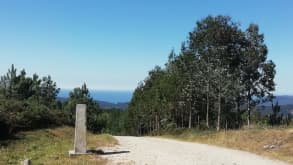

 1+
1+Day 4
Closer to Finisterre, we found more pilgrims like us. Certainly, the Camino is so popular that many people have done it more than once. We were able to share a short journey with a man from Murcia, who had walked to Santiago and Finisterre for more than 10 times. His name is Salvador and he told us many interesting stories. For example, that year, he had the opportunity to walk with “La Niña del Camino”, a small backpack that a group of people rolled from hand to hand on the Camino de Santiago, as a tribute to those who died from COVID and to the thousands of pilgrims who could not go to the pilgrimage. With all the good vibes, we arrived to Os Camiños Chans and, finally, we could see the coast. This area has the name of Ría de Corcubión and is located on the ‘Costa da morte’, Atlantic Ocean. Our destination was Cee, 18 kilometers away from Olveiroa. There, we stayed in the shelter O Bordón, a good place, where the owner is an experienced pilgrim. The place is full of photographs of the times that he walked to Santiago and Finisterre. At lunchtime, we went to the restaurant O Galego, and OMG! the food was delicious. We ate caldo gallego, a soup with potatoes and vegetables, cocido de merluza, wine, and tarta de Santiago (almond cake). All for 10 euros. After this, we walked around the coastal city. As in many areas of the north of the Iberian Peninsula, the climate in Cee is characterized by rain and fog, so we stayed a few hours in the beach and after we went to the shelter to rest.

Fisterra The end of the earth. In Finisterre the walking cycle of the pilgrims


 2+
2+Day 5
13 kilometers separated us from Finisterre and we were very excited to reach the end of our walk. Without losing sight of the ocean, we walked for almost 5 hours. I must confess, that after so many days of walking, what suffered the most from my body was my back, and I really understood the importance of carrying only the necessary things in my backpack. Fortunately, that July 31 the weather was perfect. The sun was shining in an almost cloudless sky and the sea was beating calmly on the cliff, where the Romans believed the earth ending. Everything was a party, there was music, an art exhibition and many travelers contemplating the sea. Emma and I were so happy because we could finish the Camino de Finisterre. It was 85 kilometers in which clearly our friendship grew stronger. Among the stones many pilgrims leave their shoes like an offering. It is the closing of a cycle. In our case, we did not leave our shoes, but for us, was an ending of a part of the trip, too. The same day, we had to be in Vigo, so Emma's father came to pick up and took us by car. It is rare, like after traveling at foots speed, the speed of the car feels unfamiliar. In less than 2 hours we were in Vigo. There, I had the fortune to share the holidays with Emma's family and I stayed with them in a house facing the sea, in Saiáns.

Vigo Vigo has everything: beach and mountain
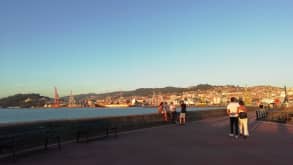

 2+
2+Day 6 and 7
Galicia is located in a privileged geographical area where its inhabitants enjoy temperate climates almost all year round. For this reason, although in central and southern Spain, August is characterized by extremely hot days, this region is perfect to stay for hours in the sun without suffering. So, after resting, Emma and I were ready to walk around Vigo. In the morning of the day 6, we went to Portiños’s beach. That beach is very quiet and recommended to relax, especially in times of COVID, because there are not many people. As the water is crystal clear, we were able to snorkel and see the marine ecosystem. In the afternoon, we went to the center of Vigo and, after watching the sunset from the port, I finally ate pulpo a la gallega. The restaurant La Comidilla is one of the places with the best recipe of this traditional dish. There you can order a complete octopus to share. “Chin chin, for one day more”, we made a toast with Albariño, a white wine.
In our second day in Vigo, we went to 2 different beaches. One of them was Samil, a long beach of light sand. There is perfect for sunbathing and, if you are lucky, the water may be warm for swimming. The other beach was Patos, a popular surfers beach. It is a good place to learn to master the waves, but if you just want to swim it is not so recommended. In the afternoon, we decided to relax in the park do Castro. That place is amazing for those who love to see the sunsets, because it is located on a small elevation in the city and you can see the sun melting into the ocean.

Ons Island Ons is one of the islands that are in the Rías of Atlantic Ocean


 4+
4+Day 8
I could not leave Vigo without visiting one of the islands that are in the Rías of Atlantic Ocean. Many tourists visit the islands, especially in summer, that is why it was important for me to plan the trip and reserve the boat tickets. Even more so with the pandemic that many things have changed. We managed to get a trip from Cangas to the Ons island. From the boat, in the distance, the mist covers the island. For a moment, it seems that we are in the middle of the sea, but little by little, the piece of land is discovered in front of us. Ons is an inhabited island so the villagers' houses immediately attract our attention. There are different trails to walk and discover the cliffs that end in the ocean. Emma and I chose a five-hour route that circled the island and ended at one of the beaches where it is possible to swim. In this place it is very important to bring our own food because there are only a few shops and a restaurant in the port. O Burato do inferno is the most curious place that we found on this island. As you can guess, its Galician name is related to hell. This 80-meter-deep crack is known for its legends and superstitions that indicate the devil takes souls through this place. The stories and the haze that covered the crack certainly scared us. A historical site that is found on this island is the lighthouse, which was opened in 1865. Which was one of the last lighthouses that worked with pressurized petroleum. It is in the highest part of the island known as O Cucorro. Later, after relaxing in the calm sea, we returned to the boat, and it took us back to Cangas. We arrived just in time for the last boat that crosses from Cangas to Vigo and we had a few minutes to walk around the village. Once we got on the boat, we saw on both sides of the Ría de Vigo, the lights on, the sea, the sky. So, we say goodbye to this trip.
Q & A
Restaurant recommendations?
To enjoy Galician food the top 3 is: O Galego, Cee; La Comidilla, Vigo and Casa Loncho, Olveiroa.Packing tips?
For a walk it is very important to carry a very light backpack. In a week you will only need three changes of underwear, three shirts and three pants. You can bring a bath towel and sandals.Booking details?
It is recommendable to download a mobile application of the Camino de Santiago to search for hostels and restaurants.
Lodging
Albergue Seminario Menor. A royal seminary, where the rooms are cells in which priests and nuns once lived. It's traditional for pilgrims.
Albergue Alto da Pena. A familiar place with group rooms for pilgrims and with a tradicional community dinner.
Albergue Casa Loncho. Great location with a good restaurant for pilgrims.
Albergue O Bordón. The owner is an experienced pilgrim and the place is located in a quiet area of the city.
Casas sobre el Mar en Vigo. A house rented in Saiáns, 20 minutes from the center of Vigo. A place surrounded by quiet beaches.
Casas sobre el Mar en Vigo. A house rented in Saiáns, 20 minutes from the center of Vigo. A place surrounded by quiet beaches.



